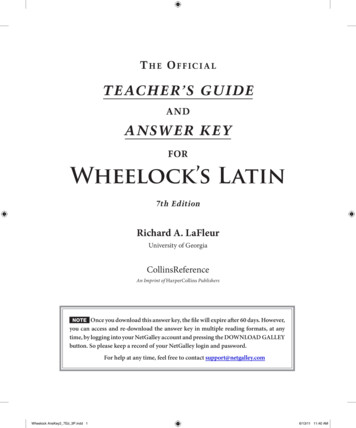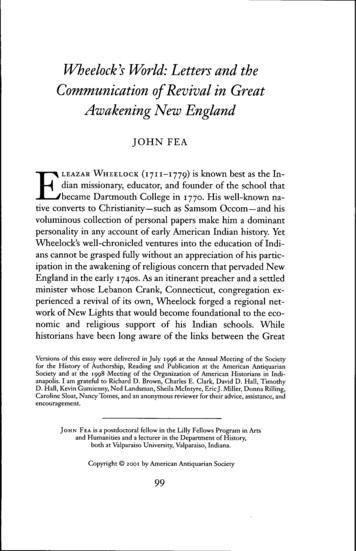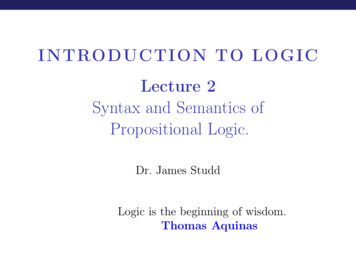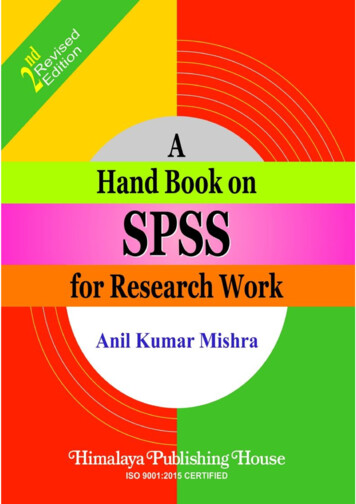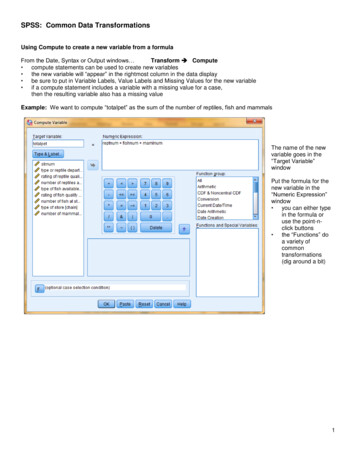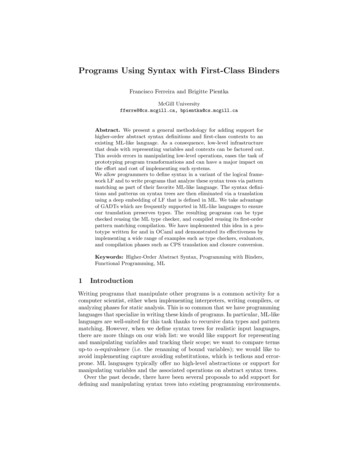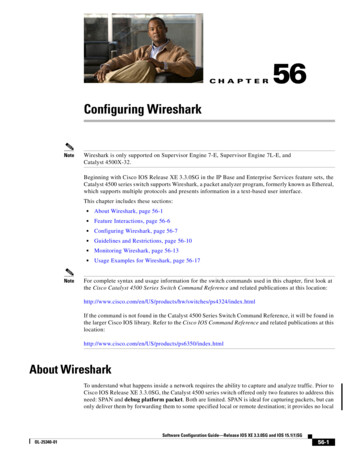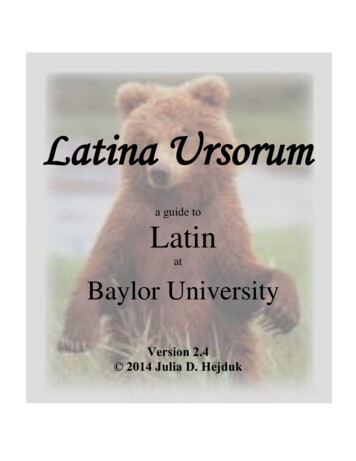
Transcription
Latina Ursoruma guide toLatinatBaylor UniversityVersion 2.4 2014 Julia D. Hejduk
page iiWhy Latina Ursorum?In Fall 2004, I found myself in front of an assortment of third-semester Latin students atBaylor University, none of whom I had laid eyes on before. Although those who had taken thefirst two semesters at Baylor had all used Wheelock’s Latin, our introductory classes comprisehundreds of students and about a dozen faculty, with disparate teaching styles. Some of thestudents were fresh out of high school. All had very different ideas about what reading Latinactually involved.I believed I had a pretty clear idea of what reading Latin involved: to translate withcomplete accuracy and understanding, which means being able to identify the form and syntax ofevery word in every sentence. The key to accomplishing this feat lies in clarity of expectationand endless repetition (i.e., making them do it from week one and never letting up). But howcould I convey exactly what I expected? And—more challenging still—how could I make iteasier and even, occasionally, a little bit fun?Thus was born Latina Ursorum: A Guide to Latin at Baylor University.Actually, that’s not entirely true. During my three lustra of teaching at Harvard, theUniversity of Texas at Arlington, and Baylor, like most Latin teachers, I had amassed a greatquantity of quizzes, tests, explanatory handouts, worksheets, mnemonic jingles, and othergoodies. But I had never attempted to pull them together into a systematic overview of thewhole language. Part of my motivation, I confess, was to give legitimacy to some of the syntaxWheelock neglects; I get tired of trying to convince my upper-level students that potentialsubjunctives and subject noun clauses are not figments of my imagination. The main goal,however, was to give motivated students a comprehensive outline of the grammar that textbooksnecessarily dole out piecemeal.To make more palatable the bitter draught of syntactical rigor, as Lucretius and JulieAndrews have reminded us, a spoonful of sugar is a must. I had often counseled my students tomake up silly songs or rhymes to help them memorize things—be honest, don’t you hear theAlphabet Song sometimes when you open a dictionary?—but I had never gone out of my way todo the composing for them. Yet once the idea of rendering Latin morphology and syntax in songwas hatched, it became a Quest. Insomnia is an amazing thing. My fevered brain could not restuntil it had fitted third-declension endings to “Row, Row, Row Your Boat,” past contrafactualconditionals to “On Top of Old Smokey” ( “On Top of Spaghetti”). If I leave behind no othermonument, I can hope that choruses of “Hic Haec Hoc” to the tune of “Jingle Bells” will be sungthroughout the ages in barbarian lands.So did it work? The answer is, I think, a resounding “sort of.” Students who are not usedto having to identify forms bristle when expected to do so. Sometimes the hardest part is simplygetting them to use the thing. (This is a problem, alas, with textbooks, too; despite repeatedprompting, many will never even find, let alone use, the Optional Exercises with Answers inWheelock.) Some just don’t like to sing (though most will smile, if only in derision, when I do).But all of them, if nothing else, now know what “identify” means, what the range of possibilitiesis, and where to turn for a quick fix on a mystifying concept. Perhaps the students of the futurewill put that knowledge to even better use. One of the nicest things about teaching is that everyyear brings new hope.
page iiiOVERVIEWof Latina Ursorum: A Guide to Latin at Baylor UniversityVersion 2.4 (8/14)DON’T PANIC!LU was developed as a supplement to Latin courses at Baylor University based onWheelock’s Latin, but it can serve the needs of students at all levels, including those who areusing a different textbook or reading unabridged Latin. Different parts will be more relevant atdifferent stages. For instance, some of the Mnemonics, especially “Declension Ditties” and“Anthology of Jingles,” will be useful as early as the first week. Latin Syntax, which gives anoutline of perhaps 95% of Latin grammar (including some not found in Wheelock), will be moreuseful to those who are marching through the latter chapters of their textbook or tackling realCicero. The Sample Quizzes and Tests (with answers) should be helpful to all. SupportingMaterials, such as “The Subjunctive Translated” and “Synopses,” give a synthetic overview ofverb forms and grammar, as well as some handy lists and “Examples and Exercises” for keygrammatical concepts.One caveat: despite its handsome and authoritative appearance, LU is not a textbook.The Latin Syntax section is intended as a review and quick reference, giving a few examples ofeach grammatical construction and fleshing out some that students will encounter when they readunabridged Latin (e.g., “Independent Subjunctives,” “Noun Clauses,” “Relative Clauses with theSubjunctive”). The occasional notes are meant merely as a supplement to the explanations inWheelock.Learning Latin is, fundamentally, simple. Every word in a Latin sentence has two basiccharacteristics: a) form (what the word is) and b) syntax (how it functions in the sentence). Thefirst step is to learn HOW TO IDENTIFY FORMS, which is thus the first page of LU (andcontains the abbreviations used throughout). The next step is to acquire, gradually, everincreasing knowledge of specific forms and syntax. Wheelock is structured so that one learnsabout 80% of the forms and 10% of the syntax in the first half of the course (at Baylor, thismeans chapters 1-22; see “Wheelock 1-22: Syntax List”), with the remaining 20% of the formsand 90% of the syntax in the second half.“Simple,” alas, does not equal “easy.” Learning Latin involves a great deal ofmemorization and the kind of intellectual precision one might expect from a math course: justabout every letter in a Latin word counts. If you can master the material outlined in LU,however, you should be qualified to read any Latin text (with a dictionary), teach Latin at anypre-collegiate level, and enter any Latin graduate program.Other than a few minor corrections, Version 2.4 differs from Version 2.3 through theaddition of hyperlinks to the songs.
page ivAs ever, Latina Ursorum remains a work in progress. I would be extremely grateful ifyou would email me any typos, errors, or suggestions for improvement, no matter how trivial.To my own students, I give an extra credit point for each typo they find: let others negotiatetheir own terms!Julia D. HejdukProfessor of ClassicsDirector, Baylor University Latin ProgramJulia Hejduk@baylor.edu
page vCONTENTSI.Latin: How to Identify Forms1II.Latin SyntaxUses of Noun CasesAblativeof meansof time within whichof time whenof personal agentof mannerof separationof degree of differenceof comparisonof place from whichof accompanimentof priceof causeof specificationof descriptionobject of prepositionof place wherewith special adjectivewith PPUFFV verbGenitiveof possessionof the whole ( partitive)of valuepredicatewith verb of accusing/condemningobjectiveobjective with impersonal verbDativeindirect objectof referenceof purposewith Chapter 35 verb2333333444444455555666677777888889
page viof possessionof separationof disadvantageof agentwith compound verbAccusativedirect objectobject of prepositionsubject in indirect statementsubject in noun clauseobjective complementof durationof exclamationof place to whichadverbialof respectful Greek body nouns and AdjectivesAttributive AdjectivesPredicate AdjectivesSubstantive AdjectivesPersonal PronounsDemonstrative Pronouns and Demonstrative AdjectivesReflexive Pronouns and Reflexive AdjectivesIntensive Prounouns and Intensive AdjectivesRelative PronounsRelative AdjectivesInterrogative Pronouns and Interrogative AdjectivesVerbsClausesSequence of TensesTypes of Subordinate ClauseNoun ClausesFear 41515161617171818191919212123
page viiConditionalsCum ClausesIndirect QuestionsResult ClausesPurpose ClausesConcessive Ut-ClausesIndirect StatementsRelative Clauses with the SubjunctiveIndependent SubjunctivesJussiveDubitativePotentialVerbal Nouns and AdjectivesParticiplesSupinesGerunds and GerundivesInfinitivesIII.Sample ExaminationsSample Quizzes (all chapters)Sample Tests(ch. 4, 6, 8, 10, 11, 12, 17, 18, 22, 30, 31, 34, 36, 38, 40)Sample Quizzes: ANSWERSSample Tests: ANSWERSIV. Supporting MaterialsThe Subjunctive TranslatedThe Present Subjunctive TranslatedThe Imperfect Subjunctive TranslatedThe Perfect Subjunctive TranslatedThe Pluperfect Subjunctive TranslatedLatin Verb Synopsis (Blank)Synopsis of laudō (1 sg f)Synopsis of moneō (3 pl f)Synopsis of agō (2 pl n)Synopsis of audiō (1 pl m)Synopsis of capiō (3 sg n)Synopsis of scrībō (2 sg 6177177178179180181182183184185186187
page viiiIndirect Statements: Examples and ExercisesIndirect Questions: Examples and ExercisesUses of the Ablative: Examples and ExercisesWheelock 1-22: Syntax ListVerbs: Wheelock 1-12 (other than regular 1st conjugation)Verbs: Wheelock 13-22 (other than regular 1st conjugation)Great Words to Introduce an Indirect StatementQ-WordsV.MnemonicsDeclension DittiesAn Anthology of JinglesConjugation ChorusesSyntax Songs188190192194195196197198200201203204206
page 1LATIN: HOW TO IDENTIFY FORMSFINITE VERB: “PaiNT MoVe”1Person Number1sg (singular)2pl (plural)3Tensepres (present)fut (future)impf (imperfect)pf (perfect)plupf (pluperfect)futpf (future perfect)MoodVoiceind (indicative)act (active)of [principal parts]ipv (imperative) pass (passive)subj (subjunctive)[inf (infinitive)]2example: moneō: 1 sg pres ind act of moneō, monēre, monuī, monitumNOUN: “CaN”Casenom (nominative)gen (genitive)dat (dative)acc (accusative)abl (ablative)voc (vocative)Numbersg (singular)pl (plural)Genderof [nom sg, gen sg] m (masculine)f (feminine)n (neuter)example: puerō: abl sg of puer, puerī, mADJECTIVE (ADJ) or PRONOUN (PRON): “KiNG”CaseNumberGenderof [nom sg m, f, n]example: malī: gen sg m of malus, -a, -umPARTICIPLE (PPL): “KiNG TV”CaseNumberGenderTenseVoiceppl of [principal parts]example: captō: abl sg m pf pass ppl of capiō, capere, cēpī, captumPrincipal parts: [1 sg pres ind act] [pres inf act] [1 sg pf ind act] [nom sg n pf pass ppl]1Words in quotation marks are mnemonics for the first letter of the terms that follow (e.g., PNTMV).The infinitive is not really a “mood,” but for convenience it will be treated as such and identified like afinite verb without person and number.2example: monēre: pres inf act of moneō, monēre, monuī, monitum
page 2II.LatinSyntax
page 3USES of NOUN CASESABLATIVENOTE: See “Uses of the Ablative: Examples and Exercises” for additionalillustrations. The Ablative Absolute is treated under “Participles.” Of all cases,the ablative is the greatest grab-bag (it picked up the functions of three IndoEuropean cases, the Ablative, the Instrumental, and the Locative).1. Urbs dēlēta est flammīs.ūnā hōrā.illō tempore.ab hostibus.magnā (cum) crūdēlitāte.The city was destroyed by flames.in one hour.at that time.by the enemy.with great cruelty.(ablatives appearing with a preposition are in [ ])flammīs:a) abl pl of flamma, ae, f.b) abl of meanshōrā:a) abl sg of hōra, -ae, f.b) abl of time within whichtempore:a) abl sg of tempus, temporis, n.b) abl of time when[hostibus]:a) abl pl of hostis, hostis, m.b) abl of personal agent
page 4crūdēlitāte:a) abl sg of crūdēlitās, crūdēlitātis, f.b) abl of manner2. Cicerō nōn carēbat librīs.erat parvō altior Caesare.cucurrit ab urbe ad mare cum amīcīs.Cicero did not use to lack books.was a little taller than Caesar.ran from the city to the sea with his friends.librīs:a) abl pl of liber, librī, m.b) abl of separation with “carēbat”parvō:a) abl sg n of parvus, -a, -umb) substantive adj; abl of degree of differenceCaesare:a) abl sg of Caesar, Caesaris, m.b) abl of comparison[urbe]:a) abl sg of urbs, urbis, f.b) abl of place from which[amīcīs]:a) abl pl of amīcus, -ī, m.b) abl of accompaniment3. Ēmimus librum magnō.We bought the book for a great price.magnō:a) abl sg of magnus, -a, -umb) Substantive adj; abl of price
page 54. Flammīs cucurrimus.We ran because of the flames.Flammīs:a) abl pl of flamma, -ae, f.b) abl of cause5. Est facile factū.It is easy to do.factū:a) abl supine of faciō, facere, fēcī, factumb) abl of specification6. Erat puella magnīs manibus.She was a girl with large hands.manibus:a) abl pl of manus, -ūs, f.b) abl of description7. Cōgitat dē pecūniā.He is thinking about money.pecūniā:a) abl sg of pecūnia, -ae, f.b) Object of preposition “dē”8. Erant multī puerī illā terrā.There were many boys in that land.terrā:a) abl sg of terrā, -ae, f.b) abl of place where
page 69. Dignī sunt amōre.They are worthy of love.amōre:a) abl sg of amor, amōris, m.b) abl with special adj10. Ūtitur pecūniā.He uses money.pecūniā:a) abl sg of pecūnia, -ae, f.b) abl with PPUFFV* verb*(potior, pascor, ūtor, fruor, fungor, vescor, deponent verbs that take the abl)NOTES:1) Remember that “ab person ” “by” (abl of agent), but “ab place ” “from”(abl of place from which).2) With the ablative of manner, “cum” can be omitted only if the noun is modified byan adjective.GENITIVENOTE: A noun in the genitive is like a barnacle, sticking to (“depending on”)another noun. The glue that holds it is the word “OF.” Most of the time (perhaps90%), simply translating a genitive as “of” and saying what noun it depends onwill do the trick. The examples below (with the exception of the gen ofpossession, which can be rendered just fine with “of”) illustrate some usageswhere “of” is NOT the best translation or the genitive does NOT depend onanother noun.1. Māter poētae bella est.The poet’s mother is pretty.
page 7poētae:a) gen sg of poēta, -ae, m.b) gen of possession depending on “Māter”2. Nihil pecūniae habēmus.We have no money.pecūniae:a) gen sg of pecūnia, -ae, f.b) Partitive gen (or: gen of the whole) depending on “Nihil”3. Ēmimus librum, sed nōn erat tantī.We bought the book, but it was not worth it. (literally, “of so great value”)tantī:a) gen sg n of tantus, -a, -umb) Substantive adj; gen of value4. Pūnīre nōn est nostrae aetātis.To punish is not a mark of/characteristic of our age.aetātis:a) gen sg of aetās, aetātis, f.b) Predicate gen5. Eōs damnāmus īnsidiārum.We condemn them for treachery.īnsidiārum:a) gen pl of īnsidiae, -ārum, f.b) gen with verb of accusing/condemning6. Cupiditās pecūniae eum dēlet.Desire for money is destroying him.
page 8pecūniae:a) gen sg of pecūnia, -ae, f.b) Objective gen; depends on “Cupiditās”7. Mē invidiae paenitet.I regret (my) envy.invidiae:a) gen sg of invidia, -ae, f.b) Objective gen with impersonal verbDATIVENOTE: The dative is “referential,” that is, it indicates whom or what somethingrefers to or concerns. When in doubt, translate with “TO,” and if that doesn’t cutit, “FOR.” The examples below illustrate some usages in which “to” and “for” arenot the best choices.1. Dā mihi librum.Give me the book. (or: “Give the book to me”)mihi:a) dat sg m/f 1st person personal pronb) i.o. (“indirect object”) of “Dā”2. Puella est tibi auxiliō.The girl is a help to you.tibi:a) dat sg m/f 2nd person personal pronb) dat of referenceauxiliō:a) dat sg of auxilium, -iī, n.b) dat of purpose
page 93. Nōn nocent puellīs.They do not harm the girls.puellīs:a) dat pl of puella, -ae, f.b) dat with Chapter 35 verb (see Wheelock Ch. 35)4. Est eīs liber.They have a book.eīs:a) dat pl of is, ea, id (demonstrative pron)b) dat of possession5. Eripuit eīs librum.He snatched the book away from them.eīs:a) dat pl of is, ea, id (demonstrative pron)b) dat of separation6. Necāvit rēgem cīvibus.He killed the king, to the disadvantage of the citizens.cīvibus:a) dat pl of cīvis, cīvis, m/fb) dat of disadvantageNOTE: This sentence (#6) could equally well be translated “He killed the king forthe citizens”; only context will tell whether something is advantageous ordisadvantageous.7. Laudandus est omnibus.He ought to be praised by all.
page 10omnibus:a) dat pl m of omnis, omneb) Substantive adj; dat of agent with passive periphrastic8. Omnibus praestat.He surpasses all (people).Omnibus:a) dat pl m of omnis, omneb) Substantive adj; dat with compound verbACCUSATIVE1. Laudat puellam.He praises the girl.puellam:a) acc sg of puella, -ae, f.b) d.o. (“direct object”) of “Laudat”2. Ībat ad montem.He was going to the mountain.montem:a) acc sg of mōns, montis, m.b) Object of preposition “ad”3. Dīcit eōs bellōs esse.He says that they are handsome.eōs:a) acc pl of is, ea, id (demonstrative pron)b) Subject of esse in indirect statement
page 114. Oportet nautam īre.It is appropriate for the sailor to go/that the sailor go.nautam:a) acc sg of nauta, -ae, m.b) Subject of “īre” in noun clause (the clause is the subject of “Oportet”)5. Appellat puerum poētam.He calls the boy a poet.poētam:a) acc sg of poēta, ae, m.b) Objective complement6. Manēbimus duās horās.We shall stay for two hours.horās:a) acc pl of hora, -ae, f.b) acc of duration7. Patriam miseram!Oh miserable fatherland!Patriam:a) acc sg of patria, -ae, f.b) acc of exclamation8. Ībimus Rōmam.We shall go to Rome.Rōmam:a) acc sg of Rōma, -ae, f.b) acc of place to which
page 129. Nihil mē cūrant.They don’t care for me at all.Nihil:a) acc sg of nihil (indeclinable)b) Adverbial acc10. Tecta caput per viās ambulāvit.Covered with respect to her head she walked through the streets.caput:a) acc sg of caput, capitis, n.b) acc of respect or Greek acc or acc of body parts or acc of respectfulGreek body partsNOMINATIVE1. Pecūnia est cūra.Money is care.Pecūnia:a) nom sg of pecūnia, -ae, f.b) Subject of estcūra:a) nom sg of cūra, -ae, f.b) Predicate nomVOCATIVE1) Et tū, Brūte?You too, Brutus?
page 13Brute:a) voc sg of Brūtus, -ī, m.b) [Direct address; vocatives stand outside the syntax of a sentence]LOCATIVE1) Est domī, non Athēnīs.He is at home, not in Athens.domī:a) loc sg of domus, -ī, f.b) [Shows place where; locatives don’t participate in syntax much either]
page 14PRONOUNS and ADJECTIVESNOTES:1) Adjectives modify nouns ( agree in case, number, and gender), unless theadjective is “substantive” (see below). When identifying non-substantiveadjectives, say what noun they modify and then give the syntax of that noun; whenidentifying substantive adjectives, give their syntax as you would for a noun.2) The categories below are not all mutually exclusive, but some of them are. Forinstance, an adjective could be both “reflexive” and “attributive,” but it could NOTbe both “attributive” and “predicative.”ABBREVIATIONS (for others, see “Latin: How to Identify Forms”):d.o. direct objecti.o. indirect objectATTRIBUTIVE ADJECTIVES give additional information about nouns. InEnglish, they always come before the noun and after the definite or indefinitearticle (if there is one). In Latin, they can be placed anywhere in the sentence,although their most common position is after the noun they modify.1. Videō portam magnam.I see the big gate.magnam:a) acc sg f of magnus, -a, -umb) Attributive adj; modifies “portam,” the d.o. of “Videō”PREDICATE ADJECTIVES usually modify the subject of a sentence with alinking verb such as “sum.” In English, they appear after the noun they modify,though not necessarily in Latin. The noun can be in a case other than thenominative, as in #3 below.2. Puer est bellus, sed nōn bonus est.
page 15The boy is handsome, but he is not good.bonus: a) nom sg m of bonus, -a, -umb) Predicate adj; modifies puer, the subject of “est”3. Habeō puerum bonum.I consider the boy good.bonum:a) acc sg m of bonus, -a, -umb) Predicate adj; modifies “puerum,” the d.o. of “Habeō”NOTE: This sentence (#3) could equally well be translated “I have a good boy”(i.e., with “bonum” an attributive adjective). Often only context and probablesense determine whether a given adjective is attributive (“I make a big cake”) orpredicative (“I make the cake big”); sometimes the Latin is truly ambiguous andthe distinction subtle.SUBSTANTIVE ADJECTIVES function as nouns (by definition, they do notmodify specific nouns). Their number and gender determine whether they refer to“man, men, woman, women, thing, things.” Identify their syntax as you would thatof a noun.4. Bonae pulchra amant.Good women love beautiful things.Bonae: a) nom pl f of bonus, -a, -umb) Substantive adj; subject of “amant”pulchra: a) acc pl n of pulcher, pulchra, pulchrumb) Substantive adj; d.o. of “amant”PERSONAL PRONOUNS refer to folks in the first person (I/we) or the secondperson (you/y’all).
page 16NOTE: Demonstrative pronouns are used for 3rd person “personal pronouns.”5. Tē laudō.I praise you.Tē:a) acc sg m/f of 2nd person personal pronb) d.o. of “laudō”DEMONSTRATIVE PRONOUNS and DEMONSTRATIVE ADJECTIVESpoint out particular people or things. (A demonstrative pronoun a demonstrativesubstantive adjective.)NOTE: Demonstrative pronouns are used to show possession in the 3 rd person bysomeone OTHER THAN the subject, but they are translated like Englishpossessive adjectives (“his, her, their”).All of the following are pronouns if they stand alone, adjectives if they modifynouns:hic, haec, hoc; ille, -a, -ud; is, ea, id; īdem, eadem, idem; iste, -a, -ud6. Hic poēta eam et eōrum mātrem amat.This poet loves her ( this/that woman) and their mother.Hic: a) nom sg m of hic, haec, hoc (demonstrative adj)b) Modifies “poēta,” the subject of “amat”eam: a) acc sg f of is, ea, id (demonstrative pron)b) d.o. of “amat”eōrum: a) gen pl m of is, ea, id (demonstrative pron)b) Depends on “mātrem”REFLEXIVE PRONOUNS (suī, sibi, sē, sē) and REFLEXIVE ADJECTIVES(suus, -a, -um) refer back to the subject of the clause. In the 3rd person, singular and
page 17plural have the same form. They appear in all cases other than the nominative andvocative.NOTE: If the subject is 1st or 2nd person, the personal pronouns (mē, tē, nōs, vōs,etc.) and possessive adjectives (meus, tuus, vester, noster, etc.) can function asreflexives.7. Laudant fīliam suam propter amōrem suī.They praise their own daughter because of love of themselves.suam: a) acc sg f of suus, -a, -um (3rd person reflexive adj)b) Modifies “fīliam,” the d.o. of Laudantsuī: a) gen pl m of 3rd person reflexive pronb) Depends on “amōrem”; refers to subject of “laudant”INTENSIVE PRONOUNS and INTENSIVE ADJECTIVES (ipse, -a, -um)emphasize particular people or things. They are pronouns if they stand alone,adjectives if they modify nouns.8. Ipse laudat urbem ipsam.He himself praises the city itself.Ipse: a) nom sg m of ipse, -a, -um (intensive pron)b) Subject of “laudat”ipsam: a) acc sg f of ipse, -a, -um (intensive adj)b) Modifies “urbem,” the d.o. of “laudat”RELATIVE PRONOUNS (quī, quae, quod) introduce relative clauses and referto a stated or (sometimes) unstated antecedent. They take their number andgender from their antecedent, their case from their function within their ownclause.9. (Vir) quem amō bellus est.
page 18The man whom I love is handsome.quem: a) acc sg m of quī, quae, quod (relative pron)b) Refers to “Vir”; d.o. of “amō”RELATIVE ADJECTIVES (not discussed in Wheelock, but slipped in on p. 120,SA #6) behave like relative pronouns except that they modify a noun within theirown clause that restates an antecedent.10. Laudō Rōmam, in quā urbe vīvēbam.I praise Rome, in which city I used to live.quā: a) abl sg f of quī, quae, quod (relative adj)b) Modifies “urbe,” the object of the preposition “in”; “quā urbe” refers backto “Rōmam”INTERROGATIVE PRONOUNS (quis, quid) and INTERROGATIVEADJECTIVES (quī, quae, quod) introduce questions.11. Quis mē laudat, et quem librum laudābō?Who praises me, and what book shall I praise?Quis: a) nom sg m/f of quis, quid (interrogative pron)b) Subject of “laudat”quem: a) acc sg m of quī, quae, quod (interrogative adj)b) Modifies “librum,” the d.o. of “laudābō”
page 19VERBSCLAUSESA “clause” is defined as “a part of a sentence containing a subject and verb.”Every sentence must contain a main clause; a simple sentence consists only of thismain clause. A complex sentence consists of a main clause and one or moresubordinate clauses. A subordinate clause cannot stand alone. For instance,consider the sentence,When I learn Latin, I shall be happy.“I shall be happy” is the main clause, and there is nothing to say about the syntax ofthe verb except that it is the “main verb.” “When I learn Latin” is the subordinateclause; it could not stand alone as a complete sentence. About the syntax of verbs inthe various kinds of subordinate clauses there is a great deal to say. For convenience,I have included in my discussion any construction that contains a subject and a verb,whether or not that verb is finite; in Latin, the sentences “I believe that he is happy”and “I believe him to be happy” are identical (Crēdō eum esse fēlīcem), and it makessense to treat all such constructions together.After an overview of the basic principle of Sequence of Tenses, there follows acatalogue of the kinds of subordinate clauses.SEQUENCE OF TENSESNOTE: For convenience, the appropriate form of English “praise” or Latin laudārewill be inserted in for illustration purposes.Main Clauseprimary pres indfut indfutpf indpf ind “have praised ” (“present perfect”)secondary pf ind “ praised ” (“simple past”)impf indplupf indSubordinate Clausepres subjpf subj“fut subj” laudāt ūrus sitimpf subjplupf subj“fut subj” laudāt ūrus esset
page 20The translation of participles and subordinate clauses depends on whether theintroductory verb is one of the primary or secondary tenses. The tense of theindicative in the main clause determines the range of possibilities for the subjunctivein the subordinate clause, as indicated by the table above. For example, if the mainclause has a present indicative, the subordinate clause will usually (say, 95% of thetime) have one of the three tenses of subjunctive for “primary sequence” (the pres, pf,or “-ūrus sit” subj), but NOT one of those for “secondary sequence” (impf, plupf, or “ūrus esset” subj).Which indicative tense is in the main clause within the given category does not(in general) affect the translation of the subordinate clause. For instance, the indirectquestion below has the same translation no matter which “primary sequence” verbintroduces it:Rogat/Rogābit/Rogāverit/Rogāvit quid faciam.He asks/will ask/will have asked/has asked what I am doing.Similarly, in secondary sequence:Rogāvit/Rogābat/Rogāverat quid facerem.He asked/was asking/had asked what I was doing.This basic principle applies to most of the constructions discussed below.
page 21TYPES OF SUBORDINATE CLAUSENOUN CLAUSESNOTE: This section is an expansion of Wheelock Chapter 36 on “Jussive NounClauses.”Sometimes an entire clause ( “sentence piece containing a subject and a verb”) canfunction as a noun, that is, as the subject or the direct object of a verb. For instance,consider the English sentence,It is necessary that we be there.“It” is merely a placeholder for the real subject, which in this case happens to be aclause:That we be there is necessary.For us to be there is necessary.The clause functions as the subject of “is,” just as “Money” does in the sentence“Money is necessary.”Similarly, consider the statement,I say that you are happy.In this sentence, “that you are happy” functions as the direct object of “say,” just as “aword” does in the sentence “I say a word.”There are two main ways of creating such clauses in Latin:1) accusative infinitive (e.g., indirect statements [discussed separately below])2) ut (or nē) subjunctive (e.g., jussive noun clauses), though ut (or nē) issometimes omittedSome of these clauses have separate names (e.g., “jussive noun clauses”), but forsome you should simply recognize that they are noun clauses functioning as thesubject or object of a verb. These can be translated in a variety of ways. Some
page 22examples:1. Efficit ut hoc faciant.He brings it about that they do this.faciant:a) 3 pl pres subj act of faciō, facere, fēcī, factumb) Verb in substantive clause of result in primary sequence2. Permīsit ut hoc facerent.He allowed them to do this.facerent:a) 3 pl impf subj act of faciō, facere, fēcī, factumb) Verb in noun clause that is the direct object of “Permīsit” in secondarysequence3. Necesse erat (ut) hoc facerent.It was necessary for them to do this.facerent:a) 3 pl impf subj act of faciō, facere, fēcī, factumb) Verb in noun clause that is the subject of “erat” in secondary sequence4. Cūrāte ut hoc faciātis.Take care to do this.faciātis:a) 2 pl pres subj act of faciō, facere, fēcī, factumb) Verb in noun clause that is the object of “Cūrāte” in primary sequence5. Oportet eōs hoc facere.It is proper for them to do this.facere:
page 23a) pres inf act of faciō, facere, fēcī, factumb) Verb in noun clause that is the subject of “Oportet” in primary sequence6. Moneō eum ut hoc faciat.I advise him to do this.faciat:a) 3 sg pres subj act of faciō, facere, fēcī, factumb) In jussive noun clause in primary sequenceNOTES:1) All “accusative infinitive” clauses function as nouns; some “ut/nē subjunctive”clauses function as nouns, while some function as adverbs (e.g., purpose clauses,result clauses).2) The jussive noun clause is generally best translated with an English infinitive, asin #6 above, whether it is in primary sequence (pres subj) or secondary sequence(impf subj); it involves asking, urging, or ordering someone to do something (seeWheelock chapter 36 for a list of verbs that commonly introduce these).FEAR CLAUSES1. Timeō nē hoc faciat.I am afraid that he may do this.faciat:a) 3 sg pres subj act of faciō, facere, fēcī, factumb) In fear clause in primary sequence2. Timēbam ut hoc faceret.I was afraid that he might not do this.faceret:a) 3 sg impf subj act of faciō, facere, fēc
of Latina Ursorum: A Guide to Latin at Baylor University Version 2.4 (8/14) DON'T PANIC! LU was developed as a supplement to Latin courses at Baylor University based on Wheelock's Latin, but it can serve the needs of students at all levels, including those who are using a different textbook or reading unabridged Latin.
